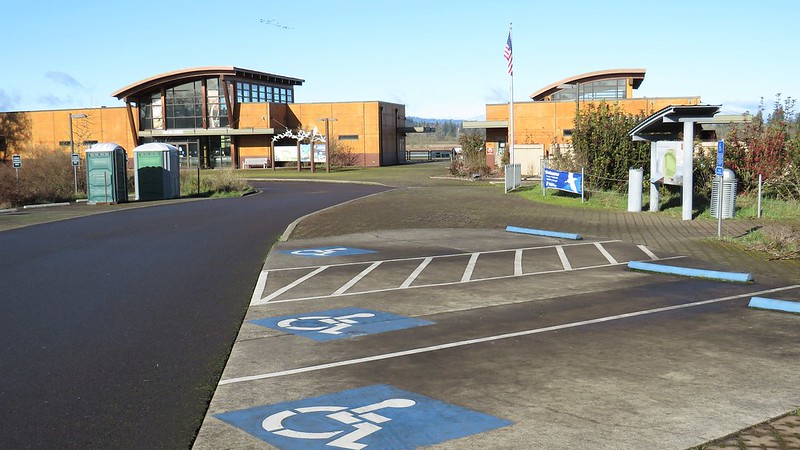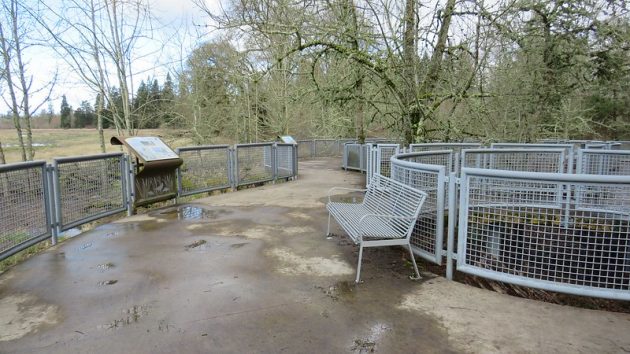
For those plugged into birding social media, it has been hard to miss the non-profit Birdability. The mission of Birdability is to “share the joys of birding with people who have disabilities, and to ensure that birding is accessible to everybody.”
Birdability was founded by Virginia Rose and she is the President. Freya McGregor is the Director of Programs and Outreach. Both have been featured on the ABA Podcast and Freya has written for the National Audubon Society, Birding magazine and the Los Angeles Times. They have also been the subject of numerous articles and have given many presentations and other talks.
Birdability is focused on all types of accessibility, from mobility issues, blindness, chronic health issues, neurodiversity, and inclusiveness, among others. To make this very broad topic somewhat manageable, this post focuses on physical accessibility.
The Birdability website features a page called “Access Considerations for Birding Locations,” which summarizes some key factors that determine whether a location is accessible. Of course, there are many different accessibility challenges and a site that is accessible to some may be inaccessible to others.
As I recently wrote, after hearing an interview with Virginia and Freya, I realized that I knew little about the accessibility of my regular birding locations. So I attempted to apply the access considerations to Tualatin River NWR near Portland, Oregon.
As a follow-up, Freya agreed to a Q&A about Birdability and its work. Her responses, lightly edited, are below, and I thank her for her time.
# # #
Q: Focusing on the physical accessibility of birding locations, what are some of the most common problems? And what, if anything, tends to get done right?
A: We have 19 access considerations in the Birdability Site Review, which is the survey people complete in order to contribute to the Birdability Map. But disability is so diverse, and everybody has different access challenges. Grade (or slope), surface type and trail width are really important for a lot of people, but shade and other sources of nearby noise can be important too. Not everybody needs a 1000% perfect accessible trail in order to enjoy birds and the outdoors, but one big barrier is not knowing the trail conditions or accessibility information ahead of time, and that’s a really common problem! Describing trails – or organized bird outings – as “easy” just isn’t enough information. (Easy for who…?!)
It’s usually pretty clear which places have prioritized accessibility in their trail design – we love seeing interpretive signs with tactile and/or audio components, for example. The most common access feature is benches! (So many people benefit from benches in outdoor settings… me and my ‘dodgy’ knee included!) We just need more benches… with armrests, connected to the surface of the trail by the same surface. (And we need to start a #BirdingByBench hashtag, I think!)

Q: How has the birding community responded to Birdability? And has that response surprised you? What aspects of Birdability’s work have particularly engaged birders?
A: The birding community has been really excited about our work. It’s so awesome! (And sometimes a little overwhelming, truthfully! But a good problem to have.) Responses fall into two categories: “Thank you so much for doing this work; as a disabled birder I finally feel seen and understood.” Or, from would-be allies, “Thank you so much! I want to be more welcoming and inclusive, but I didn’t know how. Thank you for showing me.” The emails from birders with access challenges sharing how something we did or a resource we created for them to use, and how that has made a positive impact on their birding (and so, their lives) are the ones that really get me in my loveheart. That’s what we’re doing this for!
A lot of non-disabled birders get really excited about the Birdability Map. Apart from helping share this much-needed information, it’s a concrete way they can help, and it can be such an amazing learning experience going through the process of a Birdability Site Review. And many would-be allies tell us they feel inspired by our work to empower a more welcoming and inclusive birding community. Let’s be honest – disabled or not, everybody benefits from that…!
Q: It seems like there might be some conflict between accessibility and nature. For example, the boardwalk at the Audubon Corkscrew Swamp Sanctuary surely makes for much more accessible birding (and fabulous birding for everyone), but the area loses some of the natural characteristics of the Everglades. Is there a conflict? If so, how should we think about these issues?
A: We’re not about trying to make every birding location a flat concrete trail. That is definitely not our aim. It’s not practical, and as you say, it can impact the enjoyment of being out in nature. Also, not everybody with an access challenge needs a flat, concrete trail! We’re about trying to work with what we have, and making it the best we can. Most trails that land managers describe on the maps or their websites as “accessible” could use a few important improvements… and educating land managers on this and empowering them to make the best with what they have is our approach.
There is also some evidence that supports creating really clearly designated trails to help the local ecosystem. It turns out that humans are less likely to trample off the trail and damage plants and so on if the trail has a really obvious edge or other boundary. So sometimes, making a trail more accessible – like putting a boardwalk through a swamp instead of perhaps unintentionally inviting people to just wade through wherever they want – is a good thing for nature too!
Q: I attempted to evaluate the accessibility of one of my local birding locations, Tualatin River NWR (post here and Flickr gallery here). I know it is difficult to assess a location you’ve never visited, but how did I do and what did I miss?
A: This is great, and thank you for contributing to the Birdability Map! One thing that jumps out is your assumption (which is common!) that just because a building was built after the Americans with Disabilities Act was signed into law, it must comply with the ADA Standards. Legally, yes. But… that’s entirely up to the team who constructed it, and whoever manages it. One huge problem with relying on ADA compliance (a phrase which, by the way, is often thrown around inaccurately by people trying to avoid using the word “disability”) is that there isn’t any real way to hold public buildings and spaces accountable for this. So, best not to assume.
Another thing to be wary of: You wrote that “My impression is that it’s a fairly safe area”. It’s awesome you’re thinking about safety, and this is an access consideration on it’s own! But broad sweeping statements like this (similar to, “This trail is wheelchair accessible!”) are super subjective, and you don’t know if this will apply to everybody. (Every wheelchair user has different abilities, and everyone feels safe… or not… in different situations.)
What is a lot more valuable – and what we do through the Birdability Site Review – is to share objective information, such as, if there are lots of dogs off leash at this location, or if there are lights in the parking lot. That empowers people to make up their own minds about how this access consideration will impact them. (And there are lots of safety considerations for birding locations that may or may not apply to your own personal sense of safety, but may matter to someone else.)
Finally, “handicapped” is seen as outdated and offensive by many members of the disability community. Language is always evolving, and folks may use it to describe themselves (please don’t ever tell someone that they’re identifying themselves wrongly…), but if you are nondisabled, it’s definitely recommended that you avoid this word. Accessible – or van accessible, if, indeed, it is – parking space is better. And there’s nothing offensive about the word “disability” or “disabled” – so it’s OK to use it! (There’s more general guidance on inclusive language use on our website.)
Q: Aside from being nice and respectful, what are your recommendations to individual birders, both in terms of interacting with others and advocating for accessibility?
A: Being welcoming and inclusive boils down to leading with love and kindness, an open mind, and a willingness to learn from others about their experiences and what they need to be able to participate. This doesn’t mean grilling a wheelchair user on the trail about the challenges of life in a wheelchair (this isn’t really appropriate in this context, and also not your business, after all).
This means asking people what they need to be able to participate in your outing, or to engage with your information, and doing your best to provide that. Learn from resources that are out there (our Welcoming and Inclusive Birders webpage, or the article I wrote for Audubon magazine on this topic) are great places to start…!). And create opportunities for people to share their access needs with you when signing up for bird outings, or when offering your assistance to someone on the trail. (They might not want your help, and that’s OK too!)
A final note: For would-be allies, there are lots of resources on our website to help you engage in this work. Please don’t be overwhelmed with all this new learning – everything you learn and everything you do to be more welcoming and inclusive, or to improve the accessibility of your bird outings and other programs, matters. Just start!
Follow us on social media @birdability, sign up to our newsletter, and if you’d like to help us as we continue to grow as a brand new nonprofit and work to share the joys of birding with every body, each and every donation is appreciated. Because birding is for every body!











Leave a Comment